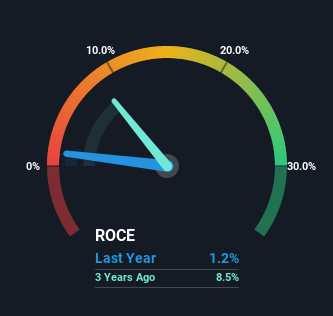Tibet Water Resources (HKG:1115) May Have Issues Allocating Its Capital

What financial metrics can indicate to us that a company is maturing or even in decline? When we see a declining return on capital employed (ROCE) in conjunction with a declining base of capital employed, that's often how a mature business shows signs of aging. Ultimately this means that the company is earning less per dollar invested and on top of that, it's shrinking its base of capital employed. On that note, looking into Tibet Water Resources (HKG:1115), we weren't too upbeat about how things were going.
What is Return On Capital Employed (ROCE)?
For those who don't know, ROCE is a measure of a company's yearly pre-tax profit (its return), relative to the capital employed in the business. Analysts use this formula to calculate it for Tibet Water Resources:
Return on Capital Employed = Earnings Before Interest and Tax (EBIT) ÷ (Total Assets - Current Liabilities)
0.012 = CN¥38m ÷ (CN¥4.1b - CN¥929m) (Based on the trailing twelve months to December 2021).
So, Tibet Water Resources has an ROCE of 1.2%. In absolute terms, that's a low return and it also under-performs the Beverage industry average of 10.0%.
View our latest analysis for Tibet Water Resources

Historical performance is a great place to start when researching a stock so above you can see the gauge for Tibet Water Resources' ROCE against it's prior returns. If you'd like to look at how Tibet Water Resources has performed in the past in other metrics, you can view this free graph of past earnings, revenue and cash flow.
What Can We Tell From Tibet Water Resources' ROCE Trend?
We aren't too thrilled by the trend because ROCE has declined 87% over the last five years and despite the capital raising conducted before the latest reports, the business has -23% less capital employed.
The Bottom Line
In summary, it's unfortunate that Tibet Water Resources is shrinking its capital base and also generating lower returns. Unsurprisingly then, the stock has dived 76% over the last five years, so investors are recognizing these changes and don't like the company's prospects. With underlying trends that aren't great in these areas, we'd consider looking elsewhere.
One more thing: We've identified 2 warning signs with Tibet Water Resources (at least 1 which shouldn't be ignored) , and understanding them would certainly be useful.
If you want to search for solid companies with great earnings, check out this free list of companies with good balance sheets and impressive returns on equity.
Valuation is complex, but we're here to simplify it.
Discover if Tibet Water Resources might be undervalued or overvalued with our detailed analysis, featuring fair value estimates, potential risks, dividends, insider trades, and its financial condition.
Access Free AnalysisHave feedback on this article? Concerned about the content? Get in touch with us directly. Alternatively, email editorial-team (at) simplywallst.com.
This article by Simply Wall St is general in nature. We provide commentary based on historical data and analyst forecasts only using an unbiased methodology and our articles are not intended to be financial advice. It does not constitute a recommendation to buy or sell any stock, and does not take account of your objectives, or your financial situation. We aim to bring you long-term focused analysis driven by fundamental data. Note that our analysis may not factor in the latest price-sensitive company announcements or qualitative material. Simply Wall St has no position in any stocks mentioned.
About SEHK:1115
Tibet Water Resources
An investment holding company, engages in the manufacture of beverages in the People’s Republic of China.
Adequate balance sheet with weak fundamentals.
Market Insights
Community Narratives



